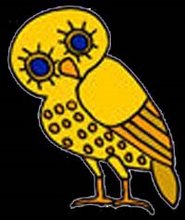 Scops Owl
Scops Owl See what others have said about their Lesvos holiday with me!
The Hotel Pasiphae is one of the best hotels on the island and is situated just inland of the coast of the northern edge of the Gulf of Kalloni. Its established itself as the hotel of choice for birders in spring. The hotel itself hosts breeding Spanish Sparrows and seemingly forever singing Nightingales. Long-eared and Scops Owls are occasionally seen too and I’ve even seen a male Collared Flycatcher and Wryneck in the garden!
Days 2 - 7
Lesvos’ main attractions are several breeding species which are very difficult to see elsewhere in Europe, and its amazing migration.
Because of its close proximity to the Turkish mainland, Lesvos enjoys a terrific migration that isolated islands fail to achieve. Our search most parts of this idyllic island and the migrants for resident and migrant breeding species and the huge number of passage migrants moving across the island to breed further north (Bulgaria, Romania, Ukraine, etc).
 Potamia Valley
Potamia Valley The Skalla Kallonis Pool lies just a few hundred yards from the hotel and provides pre-breakfast , birding for the early risers. Here you can look for the more secretive wetland species in the long grass around the small open water areas - Garganey, Little Bittern, Purple Heron and crakes are all regular. Hirundines also use the tall reeds as a roost and the incoming swirls of swallows and martins is real spectacle. The nearby sea is also worth looking over for those late departing wintering species such as Great Crested and Black-necked Grebes as well as terns and gull. The beach and saltmarsh also attract many waders and herons including Kentish Plover, Stone-curlew, Great White Egret and Black Stork.
 On our travels we will also look out for roof- and chimney- top nesting White Storks
On our travels we will also look out for roof- and chimney- top nesting White StorksThe small lake at Metochi is a real draw and we will visit it several times during the week. Here we will search the reed-fringed lake for all things secretive – crakes (possibly three species) herons, warblers. Marsh terns frequently pass through and the air is often thick with hirundines and swifts (including the occasional Pallid). The surrounding mountains provide not only a spectacular backdrop but also the chance of a raptor – Short-toed Eagle, Long-legged Buzzard, or maybe even a fly-through Eleanora’s Falcon. The lake itself boasts an enormous population of Stripe-necked Terrapins plus the chance of the much scarcer European Pond Terrapin.
 Baillon's Crake - the rarest of the crakes is found most springs at sites such as Metochi Lake or the Meladia River Ford
Baillon's Crake - the rarest of the crakes is found most springs at sites such as Metochi Lake or the Meladia River Ford

The Tsiknias River is one of the ‘wet’ rivers at this time of year. Even after the wettest of winters, many rivers soon run underground, but this river, running north from the top of the Gulf, provides a real migration corridor for many species. The river mouth is best checked early morning and late evening as its often the resting place for newly arrived migrants. Gulls, terns and waders all rub shoulders on the small spits of sand here including scarcer species such as Gull-billed Tern, godwits and Slender-billed Gull.
 Little Bitterns occur at many wetland sites and rivers
Little Bitterns occur at many wetland sites and rivers
 Olive grove - there are an estimated 11 million olive trees on Lesvos. Thats a lot of olives!
Olive grove - there are an estimated 11 million olive trees on Lesvos. Thats a lot of olives!
 Red-footed Falcons can appear anywhere on there way north to eastern European breeding grounds
Red-footed Falcons can appear anywhere on there way north to eastern European breeding groundsOne of species at the top of most visitors’ ‘need’ list is Krüper’s Nuthatch (see banner at top of page). We’ll spend a morning searching pinewoods on the edge of the Gulf of Kalloni looking for this diminutive little nuthatch which behaves more like a Blue Tit as it bounces around the pines uttering its little nasal Jay-like call.
The island boasts two areas of saltpans at Kalloni and Polichnitos. The Kalloni pans lie at the northern edge of the Gulf of Kalloni and its salt mound can be seen from all coastal parts of the Gulf for over 30kms! These pans are one of the largest in Greece and cover a huge area. During spring the saltpan company is obliged to maintain water levels for the breeding and migrant species which use the area. Many of the outlying pans are easily viewed from the access road or tracks. In recent years observation hides have been erected which helps viewing in to more distant pans. The pans themselves can be alive with migrant and breeding waders – Avocet, Wood Sandpiper, Ruff, Little Stint, Curlew Sandpiper, plus the daddy of all long-legged birds – Greater Flamingo. White and Black Storks, Grey, Purple, Squacco and Night- Herons, Spoonbill and Little and Great White can all be expected either feeding or resting up on the bunds between the pans – the latter also providing breeding sites for Stone-curlew. White-winged Black, Whiskered and Black Terns all grace the area, sometimes in flocks of over 100 birds, plus Gull-billed Tern and Mediterranean and Slender-billed Gulls. The chance of a real rarity is always on the card here, and those wader flocks, bunds and pan edges should be checked very carefully! If everything, including the flamingos take flight in panic, then look up – it might an incoming large eagle or even a pelican! A passing Osprey has a much rather reduced effect!
 View of part of the vast Kalloni Saltpans. The salt mound can be seen in the distance
View of part of the vast Kalloni Saltpans. The salt mound can be seen in the distanceThe fields surrounding the pans can be just as rewarding. After a wet winter, seasonal pools and marshes form along the southern and western areas including the Alykes Wetlands. These areas become magnets for many migrant wetland birds and passerines such as ‘yellow’ wagtails and Red-throated Pipits, Collared Pratincoles, Ruddy Shelduck plus harriers and falcons passing through looking for a snack. You should always check those ring-tail harriers as Pallid is an annual migrant here.
The second of the saltpans lies on the eastern side of the Gulf. They are much smaller than the Kalloni pans, and in spring hold limited water and so attract fewer waders, but are non-the-less worth visiting as the pans and surrounding area always provide good birding. In autumn they are a must visit site when surface water is at a real premium. Venturing down this eastern side of the Gulf also allows us to explore areas few groups get to. Depending on the day we might venture along the Almiropotamos River, explore the Agios Fokas headland, check the Vourkos River mouth or walk along the picturesque Ambeliko Valley overlooked by the might of Mount Olympus.
 The harbour at Agios Fokas
The harbour at Agios Fokas
The Napi Valley runs north from the Kalloni Saltpans. It provides a natural corridor for birds heading straight through or leaving the pans after a pit stop. We’ll search this softly-undulating valley with its tree-peppered slopes, and its surrounds, for resident and migrating raptors, Hoopoe, Middle Spotted Woodpecker, Rock Nuthatch, Sombre Tit, Black-eared Wheatear, Subalpine and Orphean Warblers and much more! Platania lies at the top of the valley and is one of the most beautiful walks on the island, and from late April plays host to Olive Tree Warbler.
 Rock Nuthcatch occurs in rocky areas across the island
Rock Nuthcatch occurs in rocky areas across the island
We will search the nooks and crannies of the north coast for migrants refuelling for the hop over to Turkey which is almost touchable here across the narrow straights. The skies are always worth checking for raptors as the hills provide the perfect thermal updrafts for northerly-heading migrants as well as thermal fun rides for breeding species such as Long-legged Buzzard and Short-toed Eagle (both on the look out Montpellier or Whip Snakes or Balkan Wall and Agama Lizards). Breeding birds include Blue Rock Thrush, Black-eared Wheatear, Masked Shrikes, Sombre Tit, Orphean Warbler and Black-headed and Cretzschmar’s Buntings (see banner at top of page), whilst offshore we’ll look for the two Medierranean shearwater species, Yelkouan (the eastern Med race of Mediterranean Shearwater) and Scolpoli’s (the eastern Med race of Cory’s) and Audouin’s Gull. This coastline is also great for butterflies Scarce Swallowtail and Cleopatra.
 The song of the Cirl Bunting is one of the ever-present sounds of Lesvos
The song of the Cirl Bunting is one of the ever-present sounds of Lesvos
 The amazing and beautiful Thread Lacewing
The amazing and beautiful Thread Lacewing
The villages and towns of this northern area are both picture postcard and varied - the beautiful fishing harbour village of Skala Sikaminias, overlooked by its inland cousin Sikaminia clinging to its hillside perch, whilst the castle-capped town of Molivos can be seen for many miles in most directions boasts a beautiful harbour and steep and narrow streets.
 Sikaminia - one of the many villages clinging to steep hillsides
Sikaminia - one of the many villages clinging to steep hillsides
 Molivos harbour
Molivos harbour
Between Petra and Molivos we will search the headland areas for migrants and the scarce breeding Rüppell’s Warbler. This scarce syvlia warbler is a star attraction with its white moustaches slicing through its black hood.
 Male Rüppell's Warbler
Male Rüppell's Warbler
Travelling west the island becomes more arid and at times utterly barren as volcanic hillsides replace the olive groves and oak-clad hills. The rocky areas are home to the rare lemon-headed Cinereous Bunting and Rock Sparrow whilst Rock Nuthatches bounce around the rocks with beakfuls of insects which they ferry to their young tucked up safely in funnel-shaped nests made of mud clinging to the face of a rock.
 Male Cinereous Bunting
Male Cinereous Bunting
Ipsilou Monastery has perched high on its mountain top and has seen more than its fair share of sackings. From its top you can view the island in all directions whilst searching the skies for raptors and swifts which are just as likely to appear below you as they are above you! Eagles, Honey-buzzard, Lesser Kestrel and Eleanora’s Falcon, Levant Sprrowhawk, Alpine and Pallid Swifts, Crag Martins and other hirundiens should all be hoped for. The tree-clad slopes may look quiet, but during a good fall the trees and bushes can be dripping with migrant warblers, flycatchers, chats, shrikes and Golden Oriole. The rocky parts of the mountain slopes should be checked for Rock Sparrow, Blue Rock Thrush, Cinereous and Cretzschmar's Buntings, Isabelline and Black-eared Wheatears and Little Owl. The meadow areas are packed with flowers and if you see a moving boulder it will be either a Chukar or Spur-thighed Tortoise! The monastery itself should be visited. Its chapel is simply stunning and Persian Squirrels scurry around the monastery walls.
 Spur-thighed Tortoise
Spur-thighed Tortoise
At the far western end of the island lies Sigri. Here the coastal fields provide a lush green oasis to tempt down hungry migrants. These fields lead to the sheltered Faneromeni River, flanked on either side by tall stands of bamboo which can provide refuge for tired migrants. If the river holds water Little Bittern and Great Snipe might be found out in the open. Lesser Kestrels and migrant harriers hunt over the surrounding hills, meadows and beaches where we also stand a change of finding such scarcities such as Roller and Collared Flycatcher.
Time permitting, in Sigri we might visit the newly opened Petrified Forest Museum (entry €5). Outside the museum lie huge stumps of a petrified trees, redwoods and pines that were covered in volcanic ash and turned to stone millions of years ago. The museum itself explains the process brilliantly and contains numerous other petrified items and geological finds from both Lesvos and further a field.
Along the 13km rough track which serves as a road connecting the towns of Sigri and Eresos, lies the Meladia River Valley. This forms a wide, flat plain at its mouth, narrowing quickly to the north pointing directly up to the mount of Ipsilou. This flat plain is one of the magnets for newly arriving migrants. The small ford pools offer shelter, food and water for Great Reed Warbler, crakes and herons. The open scrubby plain itself can swarm with ‘yellow’ wagtails, pipits and buntings, whilst the nearby fig grove can be dripping with warblers, flycatchers, Bee-eaters and Golden Orioles. Rufous Bush Robins should be on territory from early May. It’s a rare day you don’t get something here.
 The Meladia River plain
The Meladia River plain
 Rufous Bush Robin breeds near the Meladia River Mouth and many other scrubby areas across the island
Rufous Bush Robin breeds near the Meladia River Mouth and many other scrubby areas across the island
Whilst travelling around this incredibly beautiful and varied island, wherever we are we will have magnificent scenery forming stunning backdrop to our days birding.
 One of my many happy groups (and friends!) I've led around Lesvos
One of my many happy groups (and friends!) I've led around LesvosDay 8
We must bid farewell to this Aegean jewel and head home – but many of us will return!
Lunch - each day we will lunch at one of the fantastic tavernas across the island sampling the local fayre.
Dinner - each evening we will eat at the Dionysos taverna in Skala Kallonis. Be prepared for a culinery sensation! Lost of local dishes for you sample and enjoy including fresh seafood and fish. Fantastic!
What's included?
You need to make your own flight arrangements to Lesvos (I can advise you on these), but thats all you have to do. Here is what is paid for when you get there -
- transfer to and from the hotel
- B&B accommdation at the excellent Hotel Pasiphae, Skala Kallonis
- taverna lunches
- evening dinner - at the outstanding Dionysos taverna in Skala Kallonis
- the expert guiding of your very own 'Mr Lesvos' in the form of me!
So all you need to bring is a little spending money for the occasional coffee or ice cream stop, postcards and wee prezzies you might want to take home for loved ones!
Click on the following for some trip reports from some of my previous trips –
1 - 8 May 2008
Steve & Liz Dudley (Lesvosbirding.com)
List of sites visted and species seen. Several photos. (More Lesvos pictures here)
24 April - 1 May 2008
Steve Dudley (Lesvosbirding.com/Athene) & Speyside Wildlife
Detailed trip report and species lists (sorry no pictures see here)
17 - 24 April 2008
Steve Dudley (Lesvosbirding.com/Athene)
Neil Bew provides a participants insight in to a Steve Dudley led trip!
20 - 27 September 2007
Steve & Liz Dudley (Lesvosbirding.com/Athene)
List of sites visted and species seen. Several photos. (More Lesvos pictures here)
26 April - 10 May 2007
Steve & Liz Dudley (Lesvosbirding.com/Athene) & Speyside Wildlife
Detailed trip report with many pictures and species lists
20 - 27 April 2006
Steve Dudley (Lesvosbirding.com/Athene) & Speyside Wildlife
Detailed trip report and species lists
24 Sept - 1 Oct 2005
Steve Dudley (Lesvosbirding.com/Athene) & Speyside Wildlife
Detailed trip report with many pictures and species lists
14 - 21 April 2005
Steve Dudley (Lesvosbirding.com/Athene) & Speyside Wildlife
Detailed trip report and species lists (sorry no pictures see here)
22 - 29 April 2004
Steve Dudley (Lesvosbirding.com/Athene) & Speyside Wildlife
Detailed trip report and species lists (sorry no pictures see here)
25 April - 1 May 2003
Steve Dudley (Lesvosbirding.com/Athene) & Speyside Wildlife
Detailed trip report and species lists (sorry no pictures see here)
25 April - 2 May 2002
Steve Dudley (Lesvosbirding.com/Athene) & Speyside Wildlife
Detailed trip report (sorry no pictures see here)
























